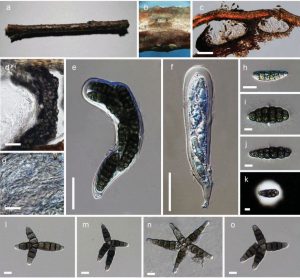Prosthemium sinense Ariyaw., K.D. Hyde & Zuo Y. Liu sp. nov., Index Fungorum number: IF 552364
Etymology: In reference to the country from which it is described
Saprobic on dead wood of Betula sp. Sexual morph: Ascomata 150–280 × 120−140 μm, solitary, scattered or in small groups, immersed, globose or depressed globose, ostiolate. Ostiole flattened, papillate, open via minute slit or a small conical swelling in the host. Peridium 25–45 μm (x̅ = 35 μm, n=10) wide, comprises one to few layers, thickened at side, thin at the base and apex. Hamathecium of 0.5–1.5 μm wide, cellular pseudoparaphyses. Asci 145–175 × 28–33 μm (x̅ = 158×32 μm, n=20), 8-spored, bitunicate, fissitunicate, broadly cylindrical to broadly cylindroclavate, with a short, thick pedicel, with a furcated pedicel and minute ocular chamber. Ascospores 37–45 × 11–14 μm (x̅ = 42×12.5 μm, n=40), obliquely uniseriate and partially overlapping to biseriate, clavate, narrowly oblong with broadly to narrowly rounded ends, muriform with 5–6 transverse septa and 1–2 vertical septa in some cells, smooth to verrucose, hyaline to pale brown when young and becoming dark brown to almost black at maturity, constricted at the septa, with a gelatinous sheath. Asexual morph: Coelomycetous. Conidia 20–40 × 9–12 μm (x̅= 36×10 μm, n=40), mostly composed of a 4–5 equally developed arms, 3–4-euseptate, stellate, brown, minutely verrucose, hyaline to pale brown at the terminal cell, constricted and connected at the central cell, central cells 7–9 μm diam, pale brown to brown, isodiametric to somewhat round.
Material examined: CHINA, Guizhou Province, Guiyang City, Huaxi District, Shunhai Park, on dead wood of Betula sp, 2 January 2016, HA Ariyawansa GAAS 100-1 (GZAAS 16-0012!, holotype), ex-type living culture (GZCC 16-0023); ibid. (MFLU!, isotype), living culture, MFLUCC.
Additional material examined: CHINA, Guizhou Province, Guiyang City, Huaxi District, Guizhou Academy of Agricultural Sciences garden, on dead wood Betula sp., 10 January 2016, SSN Maharachchikumbura GAAS 100-2 (GZAAS 16-0013!, paratype), living culture, GZCC 16-0024; CHINA, Guizhou Province, Guiyang City, Huaxi District, Guizhou Academy of Agricultural Sciences garden, on dead wood Betula sp, 14 February 2016, HA Ariyawansa GAAS 100-3 (GZAAS 16-0014!, paratype), living culture, GZCC 16-0025.
Notes: By combining multi-locus DNA sequences with detailed morphological analyses, we were able to define and propose a new species, Prosthemium sinense in the genus Prosthemium. Prosthemium sinense fits in the generic concept of Prosthemium in having immersed, globose or depressed globose ascomata, flattened, papillate ostiole open via minute slit or a small conical swelling in the host, cellular pseudoparaphyses, broadly cylindrical to broadly cylindroclavate asci, narrowly oblong, muriform ascospores and prosthemium-like asexual morph produce in culture (Sivanesan 1984, Tanaka et al. 2010, Zhang et al. 2012). Prosthemium sinense can readily be distinguished from the other species in the genus by its relatively small ascomata, asci, ascospores and relatively small, 3–4-euseptate conidia with 4–5 equally developed arms. Prosthemium sinense differs from the generic type of the genus Prosthemium, Pr. betulinum, in having smaller ascomata (120-140 μm vs 440–740 μm), asci (145–175×28–33 μm vs 180–250×28–42 μm), ascospores (37–45×11–14 μm vs 45–58×12.5–17.5 μm) and conidia (20–40×9–12 μm vs 40–55×13–16 μm) (Sivanesan 1984, Tanaka et al. 2010, Zhang et al. 2012). The asexual morph of Prosthemium sinense clearly differs from the asexual morph of Pr. stellare in the number of radiating arms per conidium (4–5 equally developed arms versus 9–14 equally developed arms) (Sivanesan 1984, Tanaka et al. 2010) (TABLE 3). The asexual morph of Prosthemium sinense differs from the asexual morph of Pr. neobetulinum in the number of radiating arms per conidium (4–5 equally developed arms versus 4 equally developed arms), size of the conidia (20–40 μm ×9–12 μm versus 17–28×8–9.5 μm) and the width of the central cell (7–9 μm versus 5–6 μm) (Sivanesan 1984, Tanaka et al. 2010) (TABLE 3). Prosthemium sinense is somewhat similar with Pr. intermedium but clearly differs in the number of radiating arms per conidium (4–5 equally developed arms versus long arm and 3 equally developed arms) and the size of the conidia (20–40 μm ×9–12 μm versus 57–73×16–23 μm (long arm) and 40–55×13–20 μm (3 equally developed short arms)).

FIGURE. Prosthemium sinense (holotype). a Herbarium material. b Close up of the ascomata on host c Section through mature ascomata. d Close up of the peridium. e, f Mature and immature asci. g Hamathecium of dense cellular, aseptate pseudoparaphyses. h, i, j, k Narrowly oblong ascospores with a clear sheath. l, m, n, o. Mature conidia produced in culture.. Scale bars: c, d = 35 μm, e-f = 40 μm, g-o = 10 μm.
